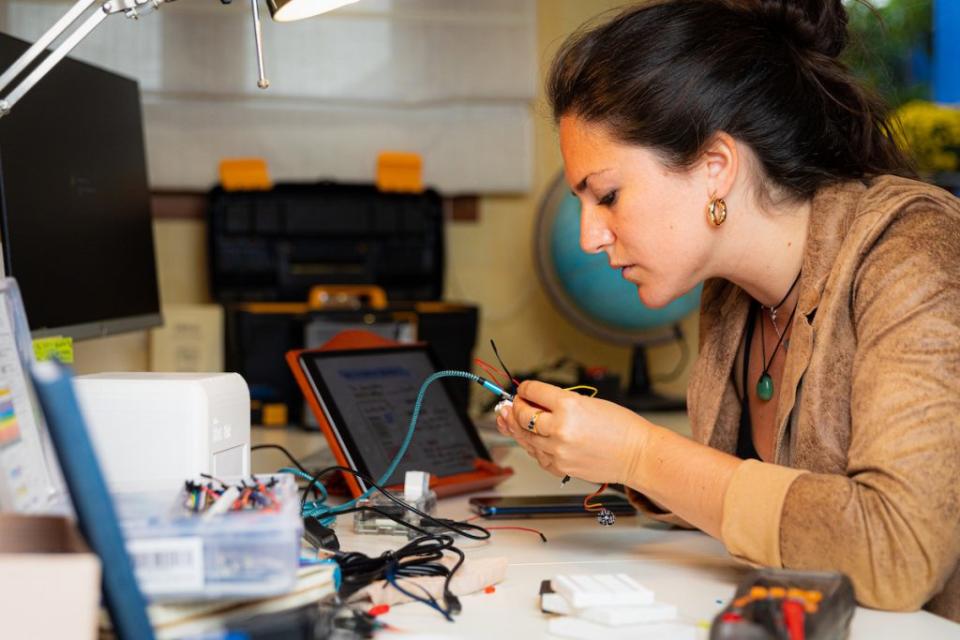A woman wanted to improve accessibility to breast cancer tests, so she created this nifty device
While studying biomedical engineering at the University of Barcelona, Judit Giró Benet came across a report that revealed that nearly 40 percent of women skipped breast cancer screening, possibly leading to at least a third of cancers being detected too late.
Upon conducting more research, the design student later learned, through the Catalan Department of Health in Spain, that approximately 94 percent of breast cancers detected by mammograms were essentially “false alarms.”
Determined to address this issue while also making screening more accessible to women, Benet drew from her interest in biology to come up with the concept of The Blue Box — an at-home breast cancer screening device.
“The way I got inspired to start developing The Blue Box is [that] I heard there was a dog that could smell cancer and bark,” she told In The Know. “I really loved this approach because I always think that, to create great design, you should observe biology and then learn from that. So I thought, ‘Yeah, nature has a way to diagnose cancer already. Let’s try to copy it.'”
In October 2017, as Benet was completing her final year at the University of Barcelona, she began working on a prototype of The Blue Box as part of her bachelor thesis. Based on her knowledge of cancer biomarkers, Benet experimented with several sensors to detect breast cancer in 90 urine samples that were collected at a hospital. According to her thesis, she wanted to prove that “the metabolite analysis performed by The Blue Box is sufficiently significant to discriminate control from breast cancer class.”
“In the design process, there [were] some challenges,” she recalled. “There [are] some things … in the papers that have been published. You have to read those … and then you have to [figure out] after learning all of these [things] what hypothesis you have.”

After her graduation, Benet spent her spare time further working on her project before devoting to it full-time as a master’s student at the University of California Irvine. While studying for her master’s degree in embedded and cyber-physical systems, she collaborated with a classmate to work on a second prototype of the Blue Box.
“The reason I did this for my master’s is because I thought, ‘Okay, The Blue Box works, but it works for advanced breast cancer.'” she said. “So, for late-stage breast cancer, I want to optimize it. I want to make it better. How can I learn what I’m lacking?”
Over the months, Benet fine-tuned her invention while making use of her classmate’s background in computer science. As it now exists, the Blue Box contains six chemical sensors, which, when in contact with any given urine sample, will react to specific breast cancer biomarkers. The device then transmits a signal to a cloud, where an AI-powered algorithm determines a diagnosis and sends the results to the user’s phone.
Following multiple iterations, Benet, now 24 years old, claims that The Blue Box now has a breast cancer classification rate of over 95 percent.
“I want The Blue Box to be a safe space for a community that unites women [who] have decided to take care of their own health,” she said. “Women have to prevent breast cancer, taking an active role together with their doctors.”
For her work, the designer was recently recognized with a James Dyson Award — a prestigious honor given to students who tackle the world’s most pressing problems.
“One of the most beautiful things that happened is that, thanks to this award, we had huge media exposure,” she said. “And, you know, our social media, we have been receiving messages from women all over the world asking like, ‘Wow, when will I be able to buy it?'”
Currently, Benet is in the process of looking for funding so that she can secure a patent and carry out more testing. Fresh off of creating her own business entity based on The Blue Box, she hopes to eventually get a government grant and FDA approval so that her device can make it to the market and especially help those in need.
“There is a need for diseases or medical conditions that affect mostly women to be treated, to be investigated and to be solved,” she said. “And this is one of the goals of The Blue Box.”
If you liked this story, check out this article on a group of inventors who similarly won the James Dyson Award for addressing one of the most ignored pollutants in the world.
More from In The Know:
Breast cancer survivor, 26, reveals why it’s never too early to get checked
This is the microphone you keep seeing all over TikTok
This warm and cozy teddy coat is affordable enough to buy in multiple colors
These best-selling $45 jeans should be in your Amazon cart, stat
The post James Dyson winner invents at-home breast cancer screening device appeared first on In The Know.

 Yahoo Finance
Yahoo Finance 